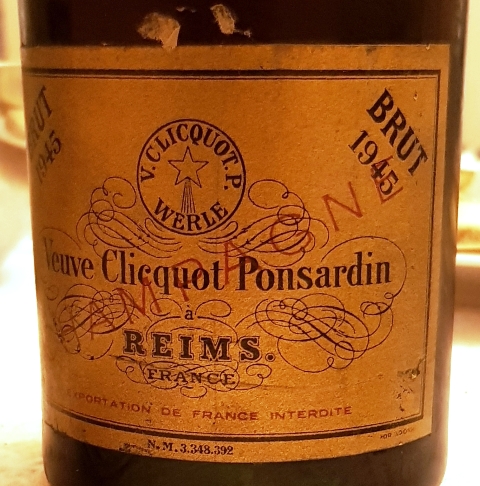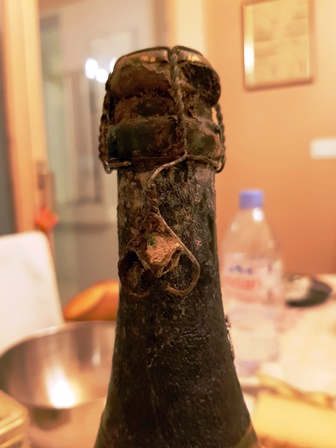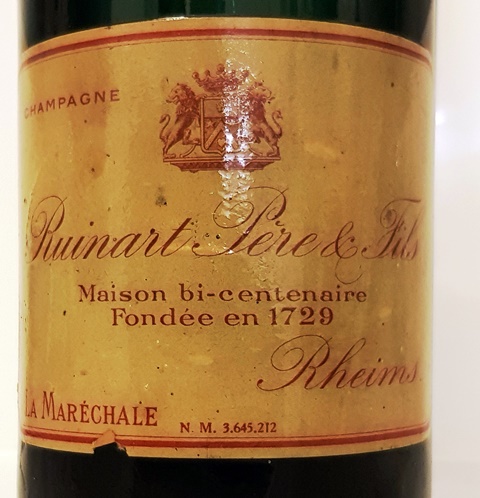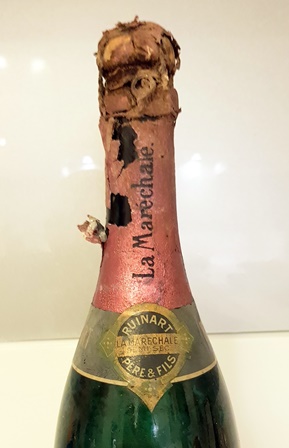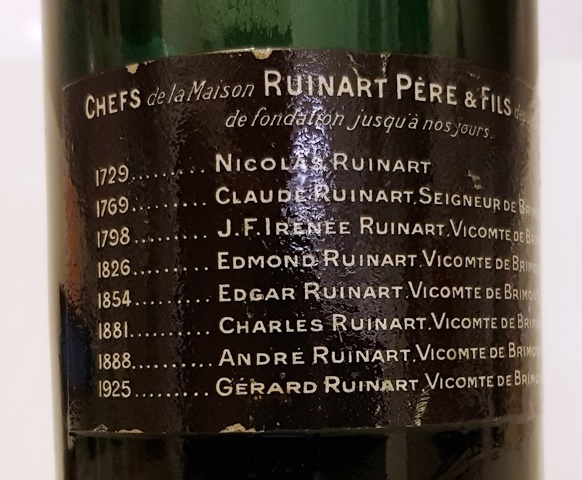At this moment of my trip in the world of wine, I like to “put myself in danger”, which means that I take more risks because I accept to take them. One of the merchants I use to work with, rather original and rather unpredictable, proposes me two wounded Champagne bottles which normally he should never try to sell and which normally I should never buy. My fault. Here is the report on a very strange experience.
When faced with a wine, must one be indulgent or critical? The problem often arises with old wines. I bought a bottle announced as a low Champagne Veuve Clicquot Ponsardin 1945. The photos taken by the seller do not allow to get a precise idea. Contrarily to a normal behavior I take my risk. When I receive the bottle sent by post, I see that the capsule that covers the cork has been covered with a spongy tissue that is damp. So the seller knew that it would leak! And in fact the bottle had leaked during transport. I remove everything that covers the bottle and the show is not very encouraging. Getting the bottle back to the seller will take me into discussions or operations that will cost time. I keep the bottle. With whom other than my son can I take the risk of opening this bottle?
This is the occasion of a simple dinner where nothing is planned for the wine. I pull the cork that breaks into the neck. It is pulled out with a corkscrew and produces no pschitt. The color is quite dark and will become darker when I serve the bottom of the bottle. The nose is quite encouraging. And it is now that mood plays its part. Many lovers would declare that the wine is dead or at least very tired. We could stop there or find out what it is saying. And under the veil of fatigue, everything that makes a great champagne is perceptible. My son is much more tolerant than I am. What bothers me is a little too strong acidity. Otherwise, the fruits are beautiful. At any moment I hesitate between the rejection and the acceptance of a champagne which still has much to say. My son accepts it. I’m like Buridan’s donkey. There was indeed now and then a great lightning of a Veuve Clicquot of a great year, followed by annoying fatigue. So, what to say? It is obviously a champagne too tired but that tells much more than many champagnes of little interest (and there are!). Some amateurs would have given up. We had the courage to go to the end, with gleams that are the reward of patient amateurs.
The more I go, the more I like the unexpected. It’s the song “surprise me Benoît” by Françoise Hardy. The supplier of the 1945 Veuve Clicquot bottle had also sold me a bottle of Ruinart from the 1930s that he felt was in danger of sagging. The two bottles were to be delivered together but in fact they were delivered separately. They call me from the company where I receive the wines I bought and they say to me: “It’s a bad thing.” I see a picture where on my desk there is a small puddle. I receive the bottle wrapped like Moses in his cradle and everything is moist, moist, with unpleasant odors. Moses was incontinent. By manipulating the package my hands smell and the smell does not leave me. I put the bottle still wet in a refrigerator to share it with my son the next day.
The day after, we will make with my son the last dinner of his stay because in the days to come he has other dinners planned under other Parisian skies. I have just received a long-awaited purchase from Denmark, also to compensate for the pressure of waiting, I take one of the bottles received for dinner.
The decor is planted. I prepare the wines for dinner. First I open the wine taken from the day’s delivery, it is a 1973 Vega Sicilia Unico at level 5 millimeters under the cap, incredible for that age. Believing the cork is stronger than it is I do not take my long steel wick but only the ordinary corkscrew and the cork broke in two, the bottom being normally impregnated as for a wine of that age. The perfume pleases me, discreet but noble, so I will do something that I do not do for a long time, I decant the wine in my most beautiful ewer, so that my son tastes blind.
I then open the Champagne La Maréchale Ruinart Père & Fils Demi-Sec that can be estimated from the 30’s or 40’s. The steel of the muselet is very strong also by turning the wire, I carry the cap which has since long a diameter less than the diameter of the neck. It must be cleaned again and again to remove any impurities. The nose surprises me because it is pure.
The bottle is curious because it is « La Maréchale » printed with big letters on the neck, then it says :
“Maison bi-centenaire fondée en 1729” and the city is printed “Rheims” and not Reims.
On the back of the bottle another label gives all the members of the family who have managed the company :
« Chefs de la Maison Ruinart Père & Fils depuis la date de fondation jusqu’à nos jours »
1729 : Nicolas Ruinart
1769 : Claude Ruinart Seigneur de Brimont
1798 : J.F. Irénée Ruinart Vicomte de Brimont
1826 : Edmond Ruinart Vicomte de Brimont
1854 : Edgar Ruinart Vicomte de Brimont
1881 : Charles Ruinart Vicomte de Brimont
1888 : André Ruinart Vicomte de Brimont
1925 : Gérard Ruinart Vicomte de Brimont
I have written to Maison Ruinart to have more information about such a bottle.
Believing that the Ruinart should normally be a disaster, as a precaution I open a Champagne Dom Pérignon 1975 that astonishes me because the cork is as pinned as that of the Ruinart, the diameter of the cork having become less than that of the neck, is indicative of a bubble loss. It is black which should not exist for a 1975.
We go to the table. The beginning of the meal is with the foie gras of a producer that we love. I serve the Ruinart. The color is beautiful and will only become dark for the last glasses poured. The nose is pure. In the mouth the wine is amazing. It is precise, warm, cheerful and it astonishes me to the highest point. It is much better than the Veuve Clicquot 1945 despite the fact that only a third of the volume remained in the bottle. I smile because it is unthinkable that this tramp bottle, even pitiful, delivers such a beautiful champagne. Never could anyone imagine that this filthy bottle could be so joyful and generous. There was only a third of the bottle, at best and from half of what I pour the liquid gets much darker. But even dark, champagne is delicious. Who can believe such a phenomenon?
And when I start pouring Champagne Dom Pérignon 1975 whose cork was not healthy, it is the Ruinart that I like the most, because there is a bitterness too strong in the Dom Pérignon. All the cursors are disrupted. But there is an explanation. I was embarrassed by the bitterness of Veuve Clicquot 1945 and I am embarrassed by the bitterness of the Dom Pérignon 1975 and I prefer the Ruinart tramp for one reason: the Ruinart is a half-dry, therefore very dosed, and this is the dosage that allows the champagne to keep all its roundness. That is an interesting observation. The foie gras serves as a miracle doctor because the bitterness of the Dom Pérignon fades and it becomes more and more pleasant. Aeration is also a solid coach for this wine.
My wife provided Iberian pig steaks Pata Negra. I pour the red wine and my son does a good quality search. He says it is not French, evokes California, evokes Vega Sicilia to dismiss it and he seeks outside of France. His research is good and I tell him that it is Vega Sicilia. He then says that if it is Vega Sicilia it must be a year like 2000. In fact it is Vega Sicilia Unico 1973. The wine is black, the nose is a rare delicacy and my son is right on the fact that there is not the slightest trace of age. It is still quite spectacular that a 44-year-old wine can be considered as having only 17. It is the magic of Vega Sicilia Unico. At first I find it discreet, calm, of course with a beautiful alcoholic presence, but playing on discretion. Now if the first piece of meat plays on the fat, the second plays on the blood and this piece of meat propels the Vega Sicilia to infinite heights because the blood vivifies the wine, making it lively and scathing. Then, this piece of meat being replaced by another, the velvet of the wine appears, imperial. What a great moment for this lord, for the Spanish wine is noble. It is almost perfect because it lacks the final menthol freshness I adore. But it is a lord.
Let’s rewind the movie for a moment. There is a Ruinart that we are ready to put to the sink and which because of its dosage has kept a sweetness that makes it pleasant. There is a Dom Pérignon 1975 rather hurt because its cork did not resist the time that started bitter and became more and more tasty. And there is a Vega Sicilia Unico 1973 which plays a little inward like a Kylian Mbappé badly awakened (a very promising French football player) and who on fatty but bloody meat is as young as a wine of 2000.
I admit humbly that for me these surprises are treasures. It is the “astonish me Benoît” that I evoked earlier. We verified that the Jort Camembert works with both the Vega Sicilia and the Dom Pérignon and we finished the Dom Pérignon on baked apples with the feeling of having lived a unique moment.
